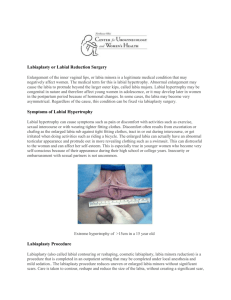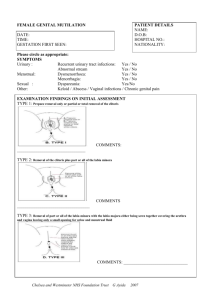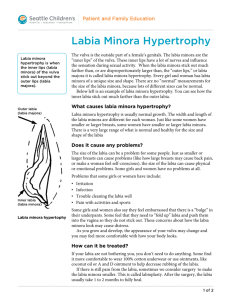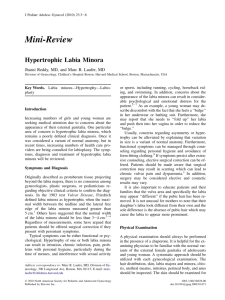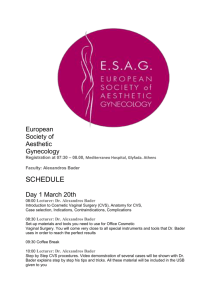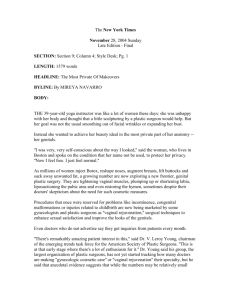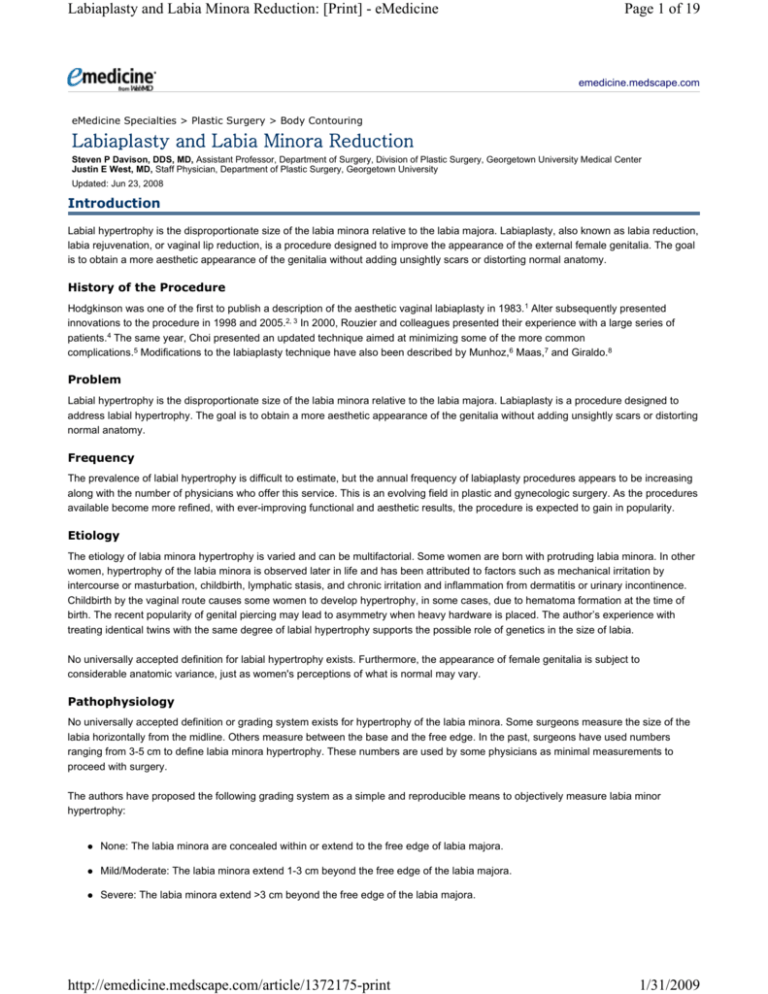
Labiaplasty and Labia Minora Reduction: [Print] - eMedicine
Page 1 of 19
emedicine.medscape.com
eMedicine Specialties > Plastic Surgery > Body Contouring
Labiaplasty and Labia Minora Reduction
Steven P Davison, DDS, MD, Assistant Professor, Department of Surgery, Division of Plastic Surgery, Georgetown University Medical Center
Justin E West, MD, Staff Physician, Department of Plastic Surgery, Georgetown University
Updated: Jun 23, 2008
Introduction
Labial hypertrophy is the disproportionate size of the labia minora relative to the labia majora. Labiaplasty, also known as labia reduction,
labia rejuvenation, or vaginal lip reduction, is a procedure designed to improve the appearance of the external female genitalia. The goal
is to obtain a more aesthetic appearance of the genitalia without adding unsightly scars or distorting normal anatomy.
History of the Procedure
Hodgkinson was one of the first to publish a description of the aesthetic vaginal labiaplasty in 1983.1 Alter subsequently presented
innovations to the procedure in 1998 and 2005.2, 3 In 2000, Rouzier and colleagues presented their experience with a large series of
patients.4 The same year, Choi presented an updated technique aimed at minimizing some of the more common
complications.5 Modifications to the labiaplasty technique have also been described by Munhoz,6 Maas,7 and Giraldo.8
Problem
Labial hypertrophy is the disproportionate size of the labia minora relative to the labia majora. Labiaplasty is a procedure designed to
address labial hypertrophy. The goal is to obtain a more aesthetic appearance of the genitalia without adding unsightly scars or distorting
normal anatomy.
Frequency
The prevalence of labial hypertrophy is difficult to estimate, but the annual frequency of labiaplasty procedures appears to be increasing
along with the number of physicians who offer this service. This is an evolving field in plastic and gynecologic surgery. As the procedures
available become more refined, with ever-improving functional and aesthetic results, the procedure is expected to gain in popularity.
Etiology
The etiology of labia minora hypertrophy is varied and can be multifactorial. Some women are born with protruding labia minora. In other
women, hypertrophy of the labia minora is observed later in life and has been attributed to factors such as mechanical irritation by
intercourse or masturbation, childbirth, lymphatic stasis, and chronic irritation and inflammation from dermatitis or urinary incontinence.
Childbirth by the vaginal route causes some women to develop hypertrophy, in some cases, due to hematoma formation at the time of
birth. The recent popularity of genital piercing may lead to asymmetry when heavy hardware is placed. The author’s experience with
treating identical twins with the same degree of labial hypertrophy supports the possible role of genetics in the size of labia.
No universally accepted definition for labial hypertrophy exists. Furthermore, the appearance of female genitalia is subject to
considerable anatomic variance, just as women's perceptions of what is normal may vary.
Pathophysiology
No universally accepted definition or grading system exists for hypertrophy of the labia minora. Some surgeons measure the size of the
labia horizontally from the midline. Others measure between the base and the free edge. In the past, surgeons have used numbers
ranging from 3-5 cm to define labia minora hypertrophy. These numbers are used by some physicians as minimal measurements to
proceed with surgery.
The authors have proposed the following grading system as a simple and reproducible means to objectively measure labia minor
hypertrophy:
None: The labia minora are concealed within or extend to the free edge of labia majora.
Mild/Moderate: The labia minora extend 1-3 cm beyond the free edge of the labia majora.
Severe: The labia minora extend >3 cm beyond the free edge of the labia majora.
http://emedicine.medscape.com/article/1372175-print
1/31/2009
Labiaplasty and Labia Minora Reduction: [Print] - eMedicine
Page 2 of 19
Presentation
Patients seeking labiaplasty often present with reports of difficulty with hygiene (toilet paper sticking), discomfort with tight clothing, pain
with bicycle riding and similar sports, labia catching in zippers, or painful intercourse due to hypertrophy of the labia minora. Perhaps the
most common is the perception that the labia minora are too visible. Many women report that the labia minora protrude beyond the labia
majora while in the standing position, leading to self-consciousness and difficulty with intimacy. An example of a patient presenting for
evaluation can be found below (Media file 1).
Another common report is asymmetry of the labia minora. Women often present to the clinic with one lip of the labia minora larger than
the other. For these women, treatment may be limited to the one side; in such cases, the goal of reduction is to match the smaller side as
closely as possible.
Labiaplasty can be safely performed any time after sexual maturity, although the author prefers a minimum patient age of 18 years. This
procedure can be performed before or after pregnancy. Surgery should be performed when the patient is not actively menstruating to
reduce potential hormonal effects on anatomy and increased risk of postoperative infection.
Indications
Patients who report nonpleasing aesthetic appearance, hygiene problems, chronic irritation, painful intercourse, and trouble with tight
clothing are all considered candidates for surgery. Although the authors' grading system is a useful tool to quantify labial hypertrophy, no
particular size or grade is used as an indication for surgery.
Relevant Anatomy
The external female genitalia are referred to collectively as the vulva. This comprises the labia majora, labia minora, clitoris, and the
openings of the urethra and vagina (Media file 2).
The labia majora, the larger outer lips, extend from the mons pubis to the rectum. Just inside the labia majora are the smaller lips, the
labia minora. In some women, they are hidden by the labia majora. In others, they are thicker and more prominent, and can extend well
past the labia majora. Such an extension may be considered for reduction.
The labia minora consist of 2 folds of connective tissue that contain little or no adipose tissue. Anteriorly and superiorly, the labia minora
divide into 2 parts. One part passes over the clitoris to form the prepuce. The other joins beneath the clitoris and forms the frenulum. The
labia minora join the labia majora in their posterior extent and may be united by a transverse fold known as the frenulum of the labia or
the fourchette. The skin and mucosa of the labia minora are rich in sebaceous glands.
The labia minora are rich in nerve endings and are usually sensitive to touch. These skin folds have a core of erectile connective tissue
analogous to the male corpus spongiosum and are covered by stratified squamous epithelium. During sexual arousal, they swell and
moisten with extracellular fluid. During urination, the labia minora function to direct the urine stream.
Contraindications
Absolute contraindications
No absolute contraindications to labia reduction surgery exist.
Relative contraindications
Labia reduction surgery is relatively contraindicated in patients who have active gynecological disease, such as infection or malignancy.
Patients who are current smokers and are unwilling to quit temporarily or permanently to optimize wound healing may be excluded.
Perhaps most importantly, patients with unrealistic goals or expectations should be appropriately counseled or excluded from surgery. In
the author’s practice, the minimum age requirement for the surgery is 18 years, at which age the patient can give her own consent.
Workup
Laboratory Studies
Routine preoperative laboratory studies appropriate for patient age and health status are sent.
Imaging Studies
http://emedicine.medscape.com/article/1372175-print
1/31/2009
Labiaplasty and Labia Minora Reduction: [Print] - eMedicine
Page 3 of 19
Routine imaging appropriate for patient age and health status is performed.
Diagnostic Procedures
Labial hypertrophy is a clinical diagnosis made when the physician performs a physical examination of the patient. No diagnostic studies
are required.
Histologic Findings
Surgical specimens are not routinely sent to the pathologist for histological examination.
Treatment
Medical Therapy
Labial hypertrophy is not managed medically.
Surgical Therapy
Labiaplasty can be performed safely with local anesthesia, conscious sedation, or traditional general anesthesia. It may be performed as
a single procedure or in conjunction with other cosmetic or gynecological procedures. The author prefers the use of 1% lidocaine with
1:100,000 epinephrine. This helps to thicken the tissues, facilitating the tissue resection. It is also helpful for hemostasis.
As with all paired structures in the human body, the labia minora are rarely perfectly symmetrical. Although size discrepancy is usually
subtle, patients often present with one lip considerably larger than the other. For those patients in which only one side is considered
large, surgery is only performed on one side. In those patients in which both sides are considered too large, but one is larger than the
other, greater resection is performed on the larger side with the goal of obtaining a reduced and symmetric result. Unilateral or bilateral
webbing between the labia majora and minora may exist and can be addressed at the same time.
Evolution of Surgical Treatment
Amputation technique
The original technique for labiaplasty involves simple amputation of that portion of the labia that is determined to be excessive. This the
most simple approach, and it is still commonly used.1, 2, 3, 4 In this technique, a clamp is placed across the area to be resected and left in
place for several minutes to establish hemostasis. The tissues are then amputated and closed. The main drawback of this technique is
the loss of the natural corrugated free edge of the labia, which results in an unnatural appearance.2, 3, 4, 5, 6, 7 This technique is also more
likely to damage nerve endings than other techniques. Furthermore, this technique may result in everting the inner lining such that the
pink-colored labial tissue, which is normally not seen, becomes visible.
Central wedge resection
First described by Dr. Alter,2 this technique involves a full-thickness resection of a wedge of tissue from within the borders of the labial
tissue. This resection pattern is advantageous over the amputation technique because it preserves the natural free edge of the labia.
However, because it is a full-thickness resection, the procedure does have the potential to cause nerve damage, which can result in
painful neuromas or numbness. Giraldo and colleagues refined this technique with the addition of a Z-plasty.8
De-epithelialization technique
This technique was described in 2000 by Dr. Choi.5 It involves de-epithelializing a central area on the medial and lateral sides of each lip
of the labia minora. The removal of the epithelium may be done with either a scalpel or laser. This technique reduces the vertical excess
while allowing preservation of the natural free edge. This important modification of Dr. Alter’s original procedure helps preserve the
sensory and erectile characteristics of the labia. The drawback of this technique is that the width of the labia may increase if a large area
needs to be deepithelialized.
Laser labiaplasty
Laser techniques have received a great deal of attention in the last several years. This technique is essentially the same as the deepithelialization technique described above, with the exception that the excess skin epidermis is removed with a laser instead of a
scalpel. The drawback is the occurrence of epidermal inclusion cysts in many patients.
http://emedicine.medscape.com/article/1372175-print
1/31/2009
Labiaplasty and Labia Minora Reduction: [Print] - eMedicine
Page 4 of 19
Labiaplasty with clitoris unhooding
Some women have thickened skin over the clitoris, which may interfere with stimulation and decrease sensitivity. A surgical procedure to
correct this, known as unhooding of the clitoris, involves a V-to-Y advancement of the soft tissues with suturing of the hood of the clitoris
to the pubic bone in the midline (to avoid the pudendal nerves). This has the effect of further tightening the labia minora.
Authors’ technique
The authors believe that no one approach is ideal and that the procedure should be tailored for the individual patient. In most cases, the
authors rely on the de-epithelialization technique to accomplish a safe reduction that preserves the natural free edge of the labia minora,
as well as sensation and tumescence. However, when the excess of tissue is significant, a combination of de-epithelialization with clamp
resection may be required to achieve the preoperative goal established by the surgeon and patient. For women with webbing of the labia
or redundant folding, the procedure is supplemented with additional techniques, such as the jumping man or 5-flap Z-plasty, to establish
a more regular and symmetric shape. An example of a patient the authors have treated can be found below (Media files 3-9).
In the author’s experience, the technique for closure can influence the aesthetic outcome. Other surgeons have used a running
absorbable suture. In the author’s experience, this has often resulted in scalloping along the scar line (Media file 10). The author
subsequently switched to using a running buried suture, which has resulted in a closure with a more natural appearance.
Preoperative Details
Evaluation should be made preoperatively with the patient in the standing position. The surgeon must understand the goals of the
patient. Markings can then be made in the operating room with the patient in the lithotomy position. The markings are made prior to
injection of local anesthesia to ensure accurate planning of tissue resection. The patient may be instructed to take antibiotics and/or
antiinflammatory medication orally beginning the night prior to surgery; if not, intravenous antibiotics are given at the commencement of
the procedure.
Intraoperative Details
For optimal exposure, the patient should be placed in the lithotomy position. The labia minora should be infiltrated using 1% lidocaine
with 1:100,000 epinephrine, and efforts should be made to preserve the markings. Prior to commencing surgery, the patient is given
intravenous antibiotics.
Postoperative Details
Postoperative care and pain is minimal, allowing patients to go home the day of surgery. After cleansing the surgical site, topical
antibiotic ointment is applied to the labia. This is done 3 times daily for 48 hours and then discontinued. No vaginal packing is needed,
although patients may find wearing a sanitary pad comforting. Patients are encouraged to take sitz baths to optimize hygiene. Patients in
the author’s practice receive a 5-day course of oral antibiotics. The patient should be made aware that the labia are often quite swollen in
the early postoperative period from infusion of local anesthetic and from edema.
Follow-up
Patients return the next day and, again, 1 week later for a follow-up visits. If patients note severe pain or swelling, they are advised to
return to the clinic for examination for the development of a hematoma.
After labiaplasty, patients can return to work or normal activity in about 3-4 days. Patients should avoid the use of tampons, tight clothing
such as thong underwear, and sexual intercourse for 4 weeks to allow adequate healing of incisions. The excellent blood supply to the
labia ensures rapid wound healing.
Complications
Complications with the procedure are not common. Those that are observed are similar to complications seen in other common surgeries
and include bleeding, infection, asymmetry, poor wound healing, under or overcorrection, and the need for revision surgery. Aggressive
resection may cause nerve damage with subsequent formation of painful neuromas. When one of the flap techniques is used, a higher
incidence of tissue necrosis has been reported. As previously mentioned, failure to use a buried suture can result in scalloping along the
free border of the labia minora (Media file 10).
Outcome and Prognosis
Authors who have presented their experience with labiaplasty report that patients are generally well satisfied with the procedure and
http://emedicine.medscape.com/article/1372175-print
1/31/2009
Labiaplasty and Labia Minora Reduction: [Print] - eMedicine
Page 5 of 19
have few complications. A study reported in 2000 showed a greater than 90% satisfaction rate in more than 150 patients who underwent
labiaplasty.4 In the author’s practice to date, all patients have reported total satisfaction. Many authors report that the reduced genitalia
greatly enhance self-esteem.1, 2, 4, 5, 6, 7, 8, 9 Furthermore, patients report improved hygiene, improved sexual intercourse, and reduction or
elimination of chronic irritation.4, 5, 6, 9
Future and Controversies
Female genital cutting (FGC) refers to amputation of any part of the female genitalia for cultural rather than medical reasons. Opponents
of these practices use the terms female genital mutilation or female circumcision. It is important to distinguish between these cultural
practices and labiaplasty, which is a surgical procedure that a woman seeks to improve a perceived functional or cosmetic problem.
Labiaplasty is not mutilation surgery and should not be confused with mutilation surgery.
Multimedia
http://emedicine.medscape.com/article/1372175-print
1/31/2009
Labiaplasty and Labia Minora Reduction: [Print] - eMedicine
http://emedicine.medscape.com/article/1372175-print
Page 6 of 19
1/31/2009
Labiaplasty and Labia Minora Reduction: [Print] - eMedicine
Page 7 of 19
Media file 1: Patient with previous abdominoplasty scar presented to clinic reporting labia minora that were too
visible.
Media file 2: External female genitalia. Labia minora are found inside the labia majora.
http://emedicine.medscape.com/article/1372175-print
1/31/2009
Labiaplasty and Labia Minora Reduction: [Print] - eMedicine
Page 8 of 19
Media file 3: Preoperative photograph of patient (lithotomy position).
http://emedicine.medscape.com/article/1372175-print
1/31/2009
Labiaplasty and Labia Minora Reduction: [Print] - eMedicine
Page 9 of 19
Media file 4: With the patient under anesthesia, the authors demonstrate redundant labia minora tissue.
http://emedicine.medscape.com/article/1372175-print
1/31/2009
Labiaplasty and Labia Minora Reduction: [Print] - eMedicine
Page 10 of 19
Media file 5: Markings for de-epithelialization on outside of labia minora.
http://emedicine.medscape.com/article/1372175-print
1/31/2009
Labiaplasty and Labia Minora Reduction: [Print] - eMedicine
Page 11 of 19
Media file 6: Markings for de-epithelialization on inside of labia minora.
http://emedicine.medscape.com/article/1372175-print
1/31/2009
Labiaplasty and Labia Minora Reduction: [Print] - eMedicine
Page 12 of 19
Media file 7: Photograph taken in operating room after surgery is complete. Note the swelling of the labia minora,
which subsides in the following weeks.
http://emedicine.medscape.com/article/1372175-print
1/31/2009
Labiaplasty and Labia Minora Reduction: [Print] - eMedicine
http://emedicine.medscape.com/article/1372175-print
Page 13 of 19
1/31/2009
Labiaplasty and Labia Minora Reduction: [Print] - eMedicine
Page 14 of 19
Media file 8: Follow-up appointment week 2. Note the decreased swelling.
http://emedicine.medscape.com/article/1372175-print
1/31/2009
Labiaplasty and Labia Minora Reduction: [Print] - eMedicine
http://emedicine.medscape.com/article/1372175-print
Page 15 of 19
1/31/2009
Labiaplasty and Labia Minora Reduction: [Print] - eMedicine
Page 16 of 19
Media file 9: Follow-up appointment week 4. The swelling has almost completely subsided, resulting in a dramatic
improvement in appearance.
http://emedicine.medscape.com/article/1372175-print
1/31/2009
Labiaplasty and Labia Minora Reduction: [Print] - eMedicine
http://emedicine.medscape.com/article/1372175-print
Page 17 of 19
1/31/2009
Labiaplasty and Labia Minora Reduction: [Print] - eMedicine
Page 18 of 19
Media file 10: Example of scalloping along free edge that can result when a running external suture technique is
used.
References
1. Hodgkinson DJ, Hait G. Aesthetic vaginal labioplasty. Plast Reconstr Surg. Sep 1984;74(3):414-6. [Medline].
2. Alter GJ. A new technique for aesthetic labia minora reduction. Ann Plast Surg. Mar 1998;40(3):287-90. [Medline].
3. Alter GJ. Central wedge nymphectomy with a 90-degree Z-plasty for aesthetic reduction of the labia minora. Plast Reconstr
Surg. Jun 2005;115(7):2144-5; author reply 2145. [Medline].
4. Rouzier R, Louis-Sylvestre C, Paniel BJ, Haddad B. Hypertrophy of labia minora: experience with 163 reductions. Am J Obstet
Gynecol. Jan 2000;182(1 Pt 1):35-40. [Medline].
5. Choi HY, Kim KT. A new method for aesthetic reduction of labia minora (the deepithelialized reduction of labioplasty). Plast
Reconstr Surg. Jan 2000;105(1):419-22; discussion 423-4. [Medline].
6. Munhoz AM, Filassi JR, Ricci MD, Aldrighi C, Correia LD, Aldrighi JM, et al. Aesthetic labia minora reduction with inferior wedge
resection and superior pedicle flap reconstruction. Plast Reconstr Surg. Oct 2006;118(5):1237-47; discussion 1248-50. [Medline].
7. Maas SM, Hage JJ. Functional and aesthetic labia minora reduction. Plast Reconstr Surg. Apr 2000;105(4):1453-6. [Medline].
8. Giraldo F, González C, de Haro F. Central wedge nymphectomy with a 90-degree Z-plasty for aesthetic reduction of the labia
minora. Plast Reconstr Surg. May 2004;113(6):1820-5; discussion 1826-7. [Medline].
9. Girling VR, Salisbury M, Ersek RA. Vaginal labioplasty. Plast Reconstr Surg. May 2005;115(6):1792-3. [Medline].
Keywords
labioplasty, labiaplasty, labia minora, cosmetic vaginal surgery, vaginoplasty, vaginal rejuvenation, labia reconstruction, labia surgery,
labial hypertrophy, labia reduction, labia rejuvenation, vaginal lip reduction, vaginal lip surgery, female genital reduction, labia minora
hypertrophy, labia minora reduction, labia minora surgery
Contributor Information and Disclosures
Author
Steven P Davison, DDS, MD, Assistant Professor, Department of Surgery, Division of Plastic Surgery, Georgetown University Medical
Center
Steven P Davison, DDS, MD is a member of the following medical societies: American Academy of Otolaryngology-Head and Neck
Surgery, American Laryngological Rhinological and Otological Society, American Medical Association, and American Society of Plastic
Surgeons
Disclosure: Nothing to disclose
Coauthor
Justin E West, MD, Staff Physician, Department of Plastic Surgery, Georgetown University
Justin E West, MD is a member of the following medical societies: American Society of Plastic Surgeons
Disclosure: Nothing to disclose
Medical Editor
Gregory Caputy, MD, PhD, Chief, Department of Plastic Surgery, Aesthetica Plastic and Laser Surgery Center of Honolulu
Gregory Caputy, MD, PhD is a member of the following medical societies: Alberta Medical Association, American Medical Association,
American Society for Laser Medicine and Surgery, Canadian Medical Association, Hawaii Medical Association, International College of
Surgeons, International College of Surgeons US Section, Minnesota Medical Association, and Pan-Pacific Surgical Association
Disclosure: Nothing to disclose
Pharmacy Editor
Francisco Talavera, PharmD, PhD, Senior Pharmacy Editor, eMedicine
http://emedicine.medscape.com/article/1372175-print
1/31/2009
Labiaplasty and Labia Minora Reduction: [Print] - eMedicine
Page 19 of 19
Disclosure: Nothing to disclose
Managing Editor
Wayne Stadelmann, MD, Stadelmann Plastic Surgery, PC
Wayne Stadelmann, MD is a member of the following medical societies: Alpha Omega Alpha, New Hampshire Medical Society,
Northeastern Society of Plastic Surgeons, and Phi Beta Kappa
Disclosure: Nothing to disclose
CME Editor
Nicolas (Nick) G Slenkovich, MD, Practice Director, Colorado Plastic Surgery Center at Swedish Medical Center
Nicolas (Nick) G Slenkovich, MD is a member of the following medical societies: American Academy of Otolaryngology-Head and Neck
Surgery, American Medical Association, American Society of Plastic Surgeons, and Colorado Medical Society
Disclosure: Nothing to disclose
Chief Editor
Jorge I de la Torre, MD, FACS, Professor of Surgery and Physical Medicine and Rehabilitation, Residency Program Director, Division of
Plastic Surgery, University of Alabama at Birmingham; Director, Center for Advanced Surgical Aesthetics
Jorge I de la Torre, MD, FACS is a member of the following medical societies: American Association of Plastic Surgeons, American Burn
Association, American College of Surgeons, American Medical Association, American Society for Laser Medicine and Surgery, American
Society for Reconstructive Microsurgery, American Society of Maxillofacial Surgeons, American Society of Plastic Surgeons, Association
for Academic Surgery, and Medical Association of the State of Alabama
Disclosure: Nothing to disclose
Acknowledgments
The authors wish to thank our 2 patients for allowing the use of their photographs for this article, as well as Dr. Allison Nauta for the illustration labeled as Media
file 2.
© 1994- 2009 by Medscape.
All Rights Reserved
(http://www.medscape.com/public/copyright)
http://emedicine.medscape.com/article/1372175-print
1/31/2009

